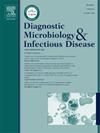The auxiliary diagnostic performance of creation tuberculin skin test for mycobacterium tuberculosis compared with QuantiFERON-TB Gold Plus: A diagnostic accuracy study
IF 1.8
4区 医学
Q3 INFECTIOUS DISEASES
Diagnostic microbiology and infectious disease
Pub Date : 2025-09-08
DOI:10.1016/j.diagmicrobio.2025.117103
引用次数: 0
Abstract
Background
For bacteriologically negative suspected tuberculosis, immunological testing provides important diagnostic evidence. The traditional tuberculin skin test has poor specificity. QuantiFERON-TB Gold Plus (QFT-Plus, the latest generation of Interferon-Gamma Release Assays) and creation tuberculin skin test (C-TST) offer higher specificity and are less affected by non-tuberculous mycobacteria and BCG vaccine. However, the efficacy of QFT-Plus and C-TST in suspected tuberculosis remain unclear. We compared the performance of the QFT-Plus with the C-TST in auxiliary diagnosing tuberculosis in individuals with suspected tuberculosis.
Methods
The subjects were 137 patients suspected of tuberculosis, including 74 pulmonary tuberculosis (PTB) patients and 63 non-active pulmonary tuberculosis. All participants underwent both QFT-Plus and C-TST testing.
Results
The sensitivities of QFT-Plus and C-TST in diagnosing PTB were 93.15 % and 86.49 %, respectively. The specificities of QFT-Plus and C-TST in diagnosing PTB were 40.35 % and 41.27 %, respectively. When QFT-Plus and C-TST were combined, the specificity increased to 58.73 %. The Area Under the Curves of Receiver Operating Characteristic in QFT-Plus and C-TST were 0.79 vs 0.67 (p < 0.05), respectively. In addition, the median IFN-γ level of TB2 tubes in the PTB group of QFT-Plus was significantly higher than that of TB1 tubes.
Conclusions
QFT-Plus and C-TST demonstrated diagnostic value in helping clinicians identify PTB and rule out non-patients to a certain extent, and the two methods had moderate agreement. The combined diagnosis statistically improved the specificity in auxiliary diagnosing PTB. Furthermore, the QFT-Plus appears more advantageous than C-TST for auxiliary diagnosing of tuberculosis.
创造结核菌素皮肤试验与QuantiFERON-TB Gold Plus辅助诊断结核分枝杆菌的比较:诊断准确性研究
背景对于细菌学阴性的疑似结核,免疫学检查提供了重要的诊断依据。传统结核菌素皮试特异性较差。QuantiFERON-TB Gold Plus (QFT-Plus,最新一代干扰素γ释放试验)和生成结核菌素皮肤试验(C-TST)具有更高的特异性,并且受非结核分枝杆菌和卡介苗的影响较小。然而,QFT-Plus和C-TST在疑似结核中的疗效尚不清楚。我们比较了QFT-Plus和C-TST在疑似结核病患者的辅助诊断中的表现。方法选取疑似肺结核患者137例,其中肺结核74例,非活动性肺结核63例。所有参与者都进行了QFT-Plus和C-TST测试。结果QFT-Plus和C-TST对肺结核的诊断敏感性分别为93.15%和86.49%。QFT-Plus和C-TST诊断肺结核的特异性分别为40.35%和41.27%。当QFT-Plus和C-TST联合使用时,特异性提高到58.73%。QFT-Plus和C-TST的受试者工作特征曲线下面积分别为0.79和0.67 (p < 0.05)。此外,QFT-Plus治疗PTB组TB2管中位IFN-γ水平显著高于TB1管。结论sqft - plus和C-TST在帮助临床医生识别PTB和排除非患者方面具有一定的诊断价值,两种方法有一定的一致性。联合诊断对辅助诊断肺结核的特异性有统计学上的提高。此外,QFT-Plus在辅助诊断结核病方面比C-TST更有优势。
本文章由计算机程序翻译,如有差异,请以英文原文为准。
求助全文
约1分钟内获得全文
求助全文
来源期刊
CiteScore
5.30
自引率
3.40%
发文量
149
审稿时长
56 days
期刊介绍:
Diagnostic Microbiology and Infectious Disease keeps you informed of the latest developments in clinical microbiology and the diagnosis and treatment of infectious diseases. Packed with rigorously peer-reviewed articles and studies in bacteriology, immunology, immunoserology, infectious diseases, mycology, parasitology, and virology, the journal examines new procedures, unusual cases, controversial issues, and important new literature. Diagnostic Microbiology and Infectious Disease distinguished independent editorial board, consisting of experts from many medical specialties, ensures you extensive and authoritative coverage.

 求助内容:
求助内容: 应助结果提醒方式:
应助结果提醒方式:


